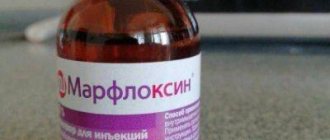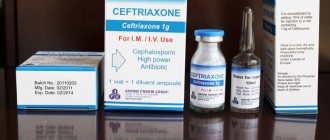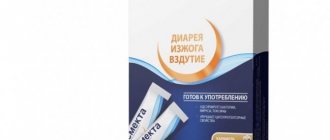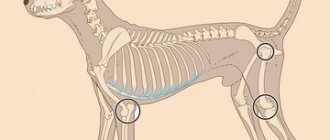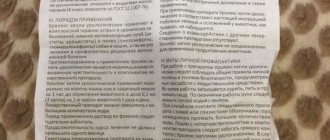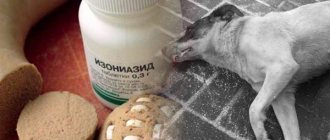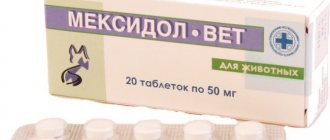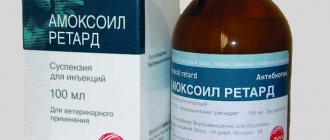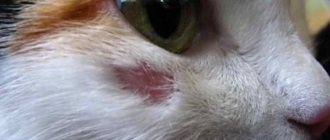Content
1. General characteristics 2. Composition and therapeutic effect 3. Purpose 4. Dosage 5. Limitations 6. Analogs 7. Video on how to dilute the medicine 8. Reviews
In veterinary medicine, the same drugs are often used to combat dangerous infectious diseases as for humans. Ceftriaxone for dogs is a real salvation when it comes to diseases that can literally lead to the death of a pet within a day. This powerful antibiotic helps put the animal back on its feet where other medications are powerless. But you cannot self-medicate - a veterinarian’s appointment is required.
Instructions for use of Ceftriaxone
Ceftriaxone is intended for intramuscular or intravenous administration. To administer, 1 g of ceftriaxone powder is diluted in 3.6 ml of a one percent lidocaine solution or in disinfected water for injection. You can also dissolve 1 g of powder in 3.6 ml of 0.25% -0.5% novocaine solution. The resulting solution will contain approximately 250 mg of ceftriaxone. The dosage per day should be 20-40 mg per 1 kg of animal weight. It is administered over 5-10 days.
It is recommended to consult a veterinarian about the method and amount of dosage.
Contraindications and side effects
Contraindicated for dogs:
- with hypersensitivity to beta-lactam antibiotics;
- with liver or kidney failure;
- are in the period of pregnancy.
Using large doses of this antibiotic can lead to gallstone disease.
general characteristics
Ceftriaxone is a broad-spectrum antibacterial drug. It successfully fights advanced and serious pathologies that can threaten the lives of pets. The injection solution is sold in a regular pharmacy and is used both in official medicine and in veterinary medicine.
An effective medicine has limitations in use and requires strict adherence to the dosage and treatment regimen, otherwise it can cause side effects, so it cannot be used for self-medication. Only a veterinarian, after examining the animal, will determine the need to take an antibiotic and draw up a treatment plan.
Price and analogues
Dispensed in pharmacies with a specialist prescription. The price for a 1 g bottle ranges from 25 to 30 rubles.
Let's look at analogues among injections:
- Claforan (France), the cost of a bottle is about 120 rubles.
- Cefotaxime (Russia), sold for 25 – 40 rubles. for 1 year
- Rocephin (Switzerland), supplied with solution for injection. The cost of the set is 530-540 rubles.
The potent antibiotic cefotaxime
Ceftriaxone is vital in a number of cases. Despite a number of contraindications and side effects, it is widely used in veterinary medicine.
Composition and therapeutic effect
The active ingredient is ceftriaxone sodium salt. The medicine is sold in the form of a powder for dilution with saline, water for injection, or novocaine. A strong antibiotic actively destroys pathogenic microorganisms and has a wide spectrum of action. It is effective against:
- staphylococci;
- coli;
- salmonella;
- clostridium;
- Haemophilus influenzae;
- shigella;
- Klebsiella;
- enterobacteria.
Once in the animal's body, the active substance of the drug destroys the walls of bacterial cells and leads to the death of pathogenic microorganisms. The main advantages of Ceftriaxone are its rapid action and the ability to destroy even those bacteria that do not die when exposed to other antibiotics.
The drug begins to act when administered intramuscularly within 1-1.5 hours. If the antibiotic is administered correctly and there are no contraindications, the medicine is harmless, but it can even fight diseases such as enteritis, which, if rapidly and acutely progresses within 24 hours, leads to the death of the animal.
What cat diseases are treated with Ceftriaxone?
The antibiotic is a broad-spectrum agent and is effective against many pathogenic microorganisms - these include various cocci (staphylococcus, pneumococcus, streptococcus), as well as E. coli, Legionella, Klebsiella, etc. Ceftriaxone injections are indicated for cats with infectious, inflammatory and septic processes caused by microorganisms sensitive to the effects of the active substance. Indications for the use of antibiotics include infections of the following organs:
- digestive tract;
- bone and nerve tissue (osteomyelitis, meningitis);
- urinary and reproductive system;
- respiratory and ENT organs.
What are antibiotics and what are they?
In addition, Ceftriaxone is often prescribed to cats after bites from other animals along with anti-rabies therapy and to prevent postoperative complications during castration, sterilization and other surgical interventions.
The drug is prescribed exclusively by a veterinarian, taking into account the clinical course of the disease, age, characteristics of the animal’s body and other factors. You cannot prescribe Ceftriaxone on your own - it can cause serious harm to the cat’s health, and also cause bacteria to become resistant to the active substance, which will make it much more difficult to cure the disease.
The drug has a wide spectrum of effects and is recommended for various infectious diseases
Attention! Despite the wide spectrum of action and effectiveness of Ceftriaxone, it is useless against Bacteroides fragilis, enterococci and some varieties of Staphylococcus aureus.
Purpose
Ceftriaxone can be considered a universal antibiotic, but it is prescribed, as a rule, for severe pathologies caused by bacteria. The list of diseases is wide:
- blood diseases;
- infectious diseases, including the skeletal system;
- ENT diseases;
- respiratory infections;
- diseases of the genitourinary system, including cystitis, pyelonephritis;
- meningitis;
- salmonellosis and other diseases of the gastrointestinal tract.
A veterinarian may prescribe Ceftriaxone to an animal after complex surgical interventions in order to prevent complications and infectious inflammation. The antibiotic is given intramuscularly, but in a hospital or veterinary clinic, intravenous administration in the form of a dropper is possible to speed up the effect of the medicine.
Important! It is prohibited to give intravenous injections and drips at home! Ceftriaxone is not administered subcutaneously.
Before the appointment, the veterinarian examines the animal. Based on the test results, the causative agent of the disease is determined.
Standard treatment regimen: the antibiotic is administered for 5-10 days once or twice a day. Double administration may be required in case of severe disease.
The daily dosage is 20-40 mg of ceftriaxone per 1 kg of dog’s body weight. As prescribed by a doctor, Ceftriaxone can be combined with drugs used in symptomatic therapy.
Important! The antibiotic is not canceled immediately after the symptoms of the disease are relieved; it must be injected for at least another three days so that the pathogenic bacteria are completely destroyed. Otherwise, they will develop resistance to the medicine and it will be useless.
How to use
According to the instructions for use, Ceftriaxone injections are given to dogs intramuscularly. You can also administer the medication intravenously, but it is difficult to administer IVs to your pet at home. In addition, this requires the professional skills of a doctor. But it is not recommended to administer the medicine subcutaneously, since painful bumps may appear at the injection site.
Injections are given once a day. In rare cases, injections are given 2 times a day if the disease is severe. The course can last from 5 to 10 days, but the duration of treatment must be determined by the doctor. The antibiotic can be combined with drugs for symptomatic therapy.
Note! After the symptoms of the disease have disappeared, injections are given for another 3 days. Only in this case will it be possible to completely destroy pathogenic microorganisms. Otherwise, bacteria will develop resistance to the drug, and the disease will become chronic.
It is advisable to give injections in the back thigh, where the largest accumulation of muscles is. It is recommended to alternately inject the antibiotic into different paws, since the injections are very painful and the injection site may hurt for a long time. If the drug is used for large pets, you should not use an insulin syringe. Firstly, with a sudden movement, the pet can break the thin needle. Secondly, it will take a long time to administer the medicinal solution, which will cause additional suffering to the animal.
Dosage
The injections are quite painful, so for intramuscular injections in dogs of small and medium breeds it is better to use an insulin syringe with a thin needle. The instructions for use recommend diluting the powder with water for injection, but in order not to cause unnecessary pain to your pet, it is better to use novocaine or lidocaine. Ceftriaxone diluted with sodium chloride is administered intravenously.
In the pharmacy, powder for preparing a solution for injection is sold in different dosages, based on this, it is diluted as follows:
| Powder in a bottle | Lidocaine | Water for injections |
| 0.5 • 1 ml | 2 % | 1 ml water for injection |
| 1 • 2 ml | 2 % | 2 ml water for injection |
Important! The standard dose is 0.12-0.16 ml of the prepared solution per 1 kg of dog weight, but the doctor can adjust it based on the pet’s condition and the advanced state of the disease.
The prepared medicine must be used within 6 hours when stored at room temperature or within 24 hours in the refrigerator. It is important to complete the entire course of treatment prescribed by your doctor so that the necessary therapeutic effect is achieved.
When to use
Ceftriaxone is usually prescribed to dogs to treat the following diseases:
- otitis;
- sinusitis, bronchitis, laryngitis and other respiratory tract pathologies;
- sepsis;
- cystitis, pyelonephritis and other diseases of the genitourinary system;
- meningitis;
- infectious lesions of bones and joints;
- purulent wounds;
- salmonellosis and other bacterial diseases of the digestive system;
- blood poisoning, etc.
Since the antibacterial agent is strong and effective, the list of pathologies for which it can be used is quite impressive. In this regard, it can be called a universal drug for the treatment of diseases caused by bacteria, but it should not be used without a doctor’s prescription.
Note! Ceftriaxone can be used in dogs. It is prescribed mainly for severe pathologies, when drugs developed specifically for animals do not cope. The medicine cannot be used for self-medication.
The drug is also used after operations for prophylactic purposes. The medicine allows you to prevent complications that manifest themselves as infectious inflammation.
Restrictions
All antibiotics require careful use. Ceftriaxone has a long list of restrictions on its use. It cannot be used if you have an individual intolerance; if you are allergic to novocaine or lidocaine, you should tell your doctor about it. Prohibitions on the use of antibacterial drugs are:
- liver failure;
- kidney pathologies;
- intolerance to cephalosporin antibiotics;
- pregnancy.
It is strictly forbidden to combine different antibiotics in treatment. The combined use of Ceftriaxone with NSAIDs may cause internal bleeding, and some diuretics taken during antibiotic therapy can cause nephrotoxic syndrome.
The list of side effects of the drug is no less long:
- nausea and vomiting;
- diarrhea;
- liver and kidney dysfunction;
- dysbacteriosis;
- change in blood formula.
When an allergic reaction develops, a rash, redness, itching appears on the body, and anaphylactic shock is possible. Therefore, veterinarians recommend that the first injection be carried out under the supervision of a specialist in order to observe the reaction of the dog’s body and be able to quickly provide the necessary assistance.
Important! The use of Ceftriaxone can cause the development of cholelithiasis, so you should not get carried away with antibiotics.
Side effects
Side effects include:
- Nausea, vomiting, diarrhea, allergic reactions.
- The drug suppresses the intestinal flora, which reduces the synthesis of vitamin K.
- It can cause glossitis (inflammation of the tongue), stomatitis (inflammation of the oral mucosa).
- There are negative consequences for the hematopoietic system (anemia, hypocoagulation and others).
- An unpleasant reaction for the animal is post-injection infiltration (hardening at the injection site).
Description of the drug ceftriaxone
Ceftriaxone is a broad-spectrum beta-lactam antibiotic that can cure many infectious diseases, such as staphylococcus, streptococcal infection, enterobacter infection, meningitis, otitis media and others. This drug prevents complications that may occur in dogs after surgery.
Active substances
The drug belongs to the third generation cephalosporin antibiotics. The Ceftriaxone bottle contains a white crystalline powder with a yellowish tint in the form of a sodium salt, which has hygroscopic properties.
Release form
Ceftriaxone is available in glass ampoules containing 0.25g, 0.5g, 1g, 2g sodium salt, packaged in ten pieces in cardboard boxes.
I INSPIRE ❤ I PLEASURE ❤ I HELP
Ceftriaxone is a third-generation drug from the “Cephalosporins” group of antibiotics.
Ceftriaxone is an inexpensive, effective and quite popular drug in veterinary practice.
The antibiotic is prescribed for a huge number of diseases, it relieves inflammation well, the drug is strong, with a wide spectrum of action.
Ceftriaxone is prescribed for 7-10 days. The drug is taken 1 time per day.
Usually the drug is stopped three days after the temperature has normalized and all symptoms have disappeared. It is extremely important to complete the entire course of treatment and not interrupt it when the animal’s condition improves.
The drug begins to act 2-3 hours after administration; to achieve results, you must complete the full course, even when the symptoms of the disease have disappeared. However, if after 3-5 days there is no improvement, and even more so if the condition worsens, you should immediately contact a veterinarian.
The injections are painful, so we will dilute the drug with novocaine 0.5%. It is possible to use lidocaine, but when using it, allergic reactions, heart and breathing problems are possible! Water for injection is also acceptable, but the animal will experience severe pain. Therefore, Novocain 0.5% is the best option.
- Add 5 ml Novocaine 0.5% into a bottle of ceftriaxone (1 g).
- Mix well, the solution should become homogeneous and yellow in color.
- We fill the syringe with the required amount of medicine, usually 1-1.5 ml per 5 kg of animal weight. Read below for the exact dosage.
- We dispose of the bottle with the remaining medicine; it cannot be stored!
The dosage is determined based on the weight of the animal. 20-40 mg of antibiotic is administered per 1 kg
- For cats and dogs weighing less than 2 kg - 0.5 of the prepared solution.
- For cats and dogs weighing about 3-4 kg, 1 ml of the finished medicine is prescribed.
- For cats and dogs weighing more than 4 kg, the dosage is increased, so for a cat weighing 4.5 kg, the dosage will be 1.3 ml of the finished medicine. (provided that the powder was diluted with 5 ml of novocaine 0.5%)
Overdose is dangerous. The exact dosage is prescribed by the attending physician. However, if there is no opportunity to see a doctor, then the average dosage is 1 ml of a ready-made, properly diluted drug per 5 kg of animal weight.
Ceftriaxone is injected into the muscle of the hind paw, alternating paws.
We administer the medicine slowly.
If Ceftriaxone does not get into the muscle, but the injection is administered, nothing needs to be changed. We give the next injection exactly one day later. If ceftriaxone is accidentally injected into the withers, the actions are exactly the same, nothing bad will happen, monitor the pet’s condition, don’t worry. And there is no need to redo the injection, the animal has received the drug. However, in the future you should be careful and inject the medicine into the muscle!
Remember that the drug must be prescribed by a doctor. And the dosage and course of treatment are determined individually in each specific situation. The above recommendations were received from a veterinarian, but do not replace an in-person consultation, examination of the animal and tests.
This is interesting:
Hello, today there will be a big article on the behavior of dominant dogs, I will tell you how we deal with...
Source treimut.ru
Release form and composition of ceftriaxone
A number of animal diseases can only be cured with antibiotics. Ceftriaxone is a powerful broad-spectrum drug.
Produced in Russia and abroad. Successfully used in veterinary medicine.
The antibacterial agent is produced in the form of a crystalline powder. The normal color is white, sometimes yellowish. Ceftriaxone (sodium salt) is packaged in 2 g, 1 g, 0.5 g, 0.25 g. For cats and dogs, the optimal bottle contains 0.5 g, 1 g of the medicinal substance.
One bottle can contain 0.5 g, 1 g or 2 g of dry product, from which a solution for injection is prepared
Vials of the drug are supplied in cardboard boxes of 10 pcs. in each. Packages with large quantities are designed for hospitals.
